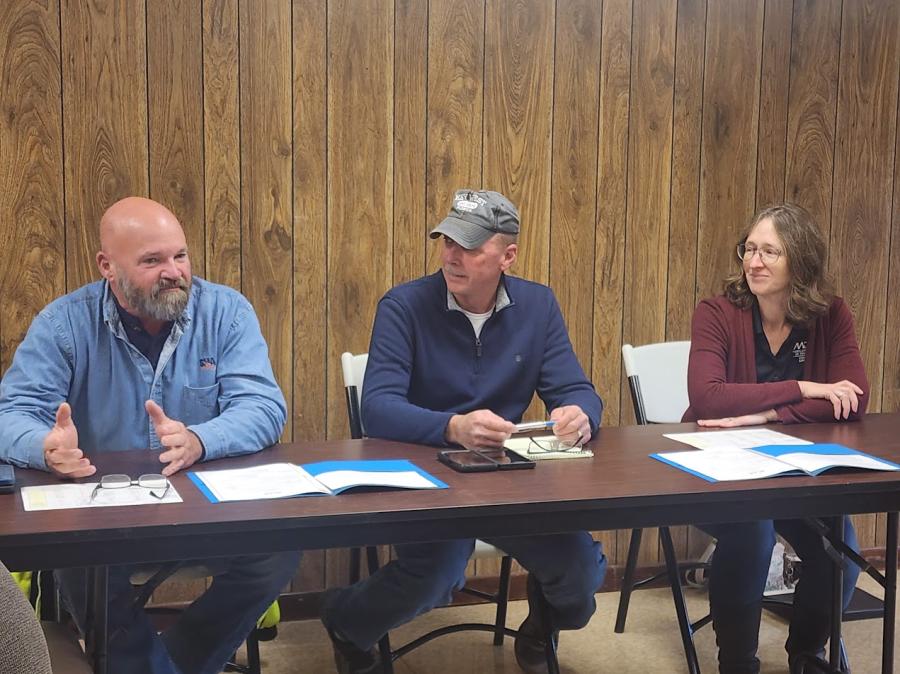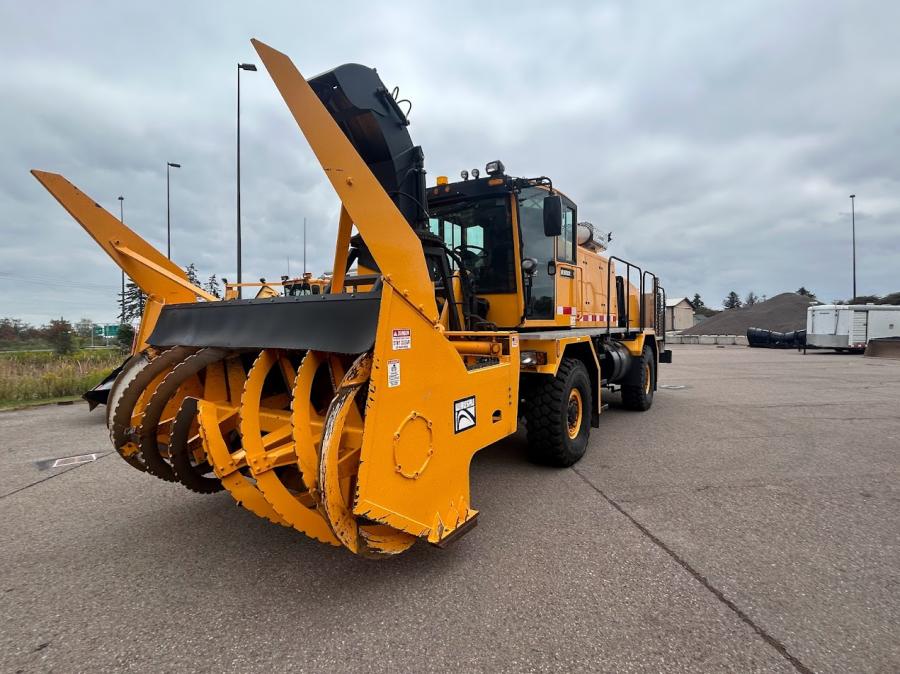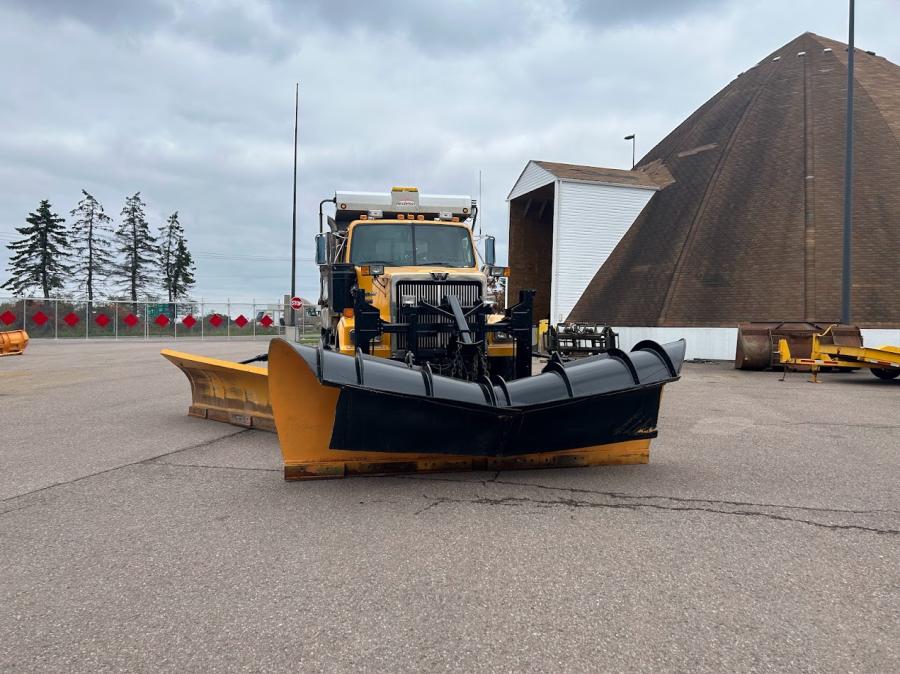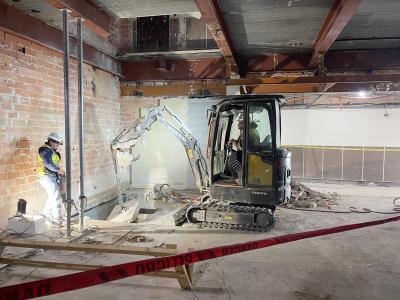The annual “Snow Show” for the Maryland Department of Transportation State Highway Administration District 6 was held on Oct. 18, 2023, at the Keyser’s Ridge Maintenance Shop.
(CEG photo)
The annual "Snow Show" for the Maryland Department of Transportation State Highway Administration District 6 was held on Oct. 18, 2023, at the Keyser's Ridge Maintenance Shop.
The event was an opportunity for the SHA to share snow removal plans and demonstrate the equipment available to tackle the upcoming winter season.
District 6 includes Garrett, Allegany and Washington counties. It is the western most district and receives the most snow in the state.
In Garrett County, last year's snowfall totaled 122.8 in. In the 2021-22, 126.5 in. were reported, and in 2020-21, 164.3 in. Allegany County received 64.26 in. of snow last year, 64.2 in. in 2021-22 and 93.4 in. in 2020-21. Washington County received 16.5 in. of snow last year, 31.6 inches in 2021-22 and 65.85 in. 2020-22.
Numerous strategies are at the ready depending on the circumstance to tackle the snow. They include anti-icing, de-icing, liquid salt brine and loader scales. Material selection is subject to change dependent on the road and weather conditions.
At SHA's disposal is rock salt that can melt snow from 20 F and above, salt brine that is dispersed prior to a snowfall and solar salt, which is a cleaner product used to make the brine.
Garrett County has decreased its salt usage by 50 to 75 percent over the past five years.
More than 200 pieces of equipment are available for snow events in the district, including 67 single dump trucks, 27 loaders and seven blowers. Equipment also includes 600 truck-mounted saddle tanks, 310 wing plows, 38 truck/trailer-mounted liquid applicator spray tanks, 15 salt brine makers, two tow plows, four dual-wing plows, 23 quad-axle trucks, 78 non-invasive road sensors and 102 Mobile Advanced Road Weather Information Sensors (MARWIS).
District 6 maintains more than 1,900 lane mi. and with snowfall totals of more than 324 in. for the 2022-2023 season maintenance crews are ready for this upcoming winter.
Winter operation planning is a continuous process. With contracts for more 150-plus hired contractors in addition to the SHA staff, equipment to maintain and materials to be ordered, winter operations are a constant part of the maintenance efforts.
In Garrett County, SHA covers 513 lane mi. There are seven barns/domes, 25,000 tons of salt, 42,000-gal. capacity for salt brine and 24,000 tons of aggregate/abrasives.
The main shop is located at Keyser's Ridge, with satellite shops located in Oakland, Swanton, Frostburg and Red House.
In Allegany County, SHA covers 605 lane mi. There are six barns/domes with 20,410 tons of salt, 68,000 gal. of salt brine and 3,300 tons of aggregate/abrasives. The main shop is located in LaVale, with satellite shops in Frostburg, Cumberland, Westernport, Little Orleans and Oldtown.
In Washington County, SHA covers 788 lane mi. The are six barns/domes with 21,600 tons of salt, 66,000 gal. of salt brine and 420 tons of aggregate/abrasives. The main shop is in Hagerstown, with satellites in Parkhead, two locations in Hagerstown, Smithsburg and Boonsboro.
In attendance at the Snow Show to join the discussion and answer questions were Linda Puffenbarger, district engineer, D6; George Walker, assistant district engineer, D6 — maintenance; Trip Martin — resident maintenance engineer at Keyser's Ridge; Todd Dewitt, assistant resident maintenance engineer; Rodney "Butch" Glenn, resident maintenance engineer at the Hagerstown shop; and Shelley Miller, D6 community relations manager.
"As far as equipment, we have no new equipment this year for different reasons," Walker said. "But we are concentrating right now on managing what we have, enhancing what we have and keeping what we have operational as best we can."
He added that SHA is emphasizing to its people to maintain equipment and keep it going as best they can, including repairs.
However, Walker mentioned that one of the main concerns this year is to be able to find and get parts for the fleet.
"Everybody is fighting with the lack of parts or the ability to obtain parts," he said. "We're doing our due diligence to try to stock up on parts that we know we normally need. But if something out of the ordinary breaks, we're having difficulty getting it just like everybody else."
DeWitt said that all the trucks are big-bore trucks, with standard transmission.
"Everything we have is retrofitted with a right wing," he said. "Twelve-foot plows, they're plowing a 10-foot surface with an eight-foot wing, which is probably catching an additional six feet."
He added that on the freeways, crews plow in trains. All of the roads are cut down into specific sections, so they all have turnaround points.
In Garrett County, DeWitt said that there is one blower on each end of the county, as well as one loader blower on each end, one grader on each end and one Oshkosh on each end.
"We can pretty well maintain both ends of the county depending on where we go," he said.
Equipment also is sent statewide to help wherever needed.
"Big equipment, we take that out when it's needed," DeWitt said. "I try not to put it out when it's extremely cold, because it's hard on the equipment. It also depends on traffic volume and the type of storm."
He said that the Oshkosh is a four-wheel drive truck with a plow on the front and a wing on the side.
"Typically, we use that during major blizzard events, he said. "I'll send somebody out. They'll push and wing back with that big truck — we'll put weight in the bed of it. It's like a mega truck, basically. It takes two people to operate it. We don't usually lose road during the daytime hours because you have the sun on your side. It's more at night."
DeWitt added that the loader blowers have the same principle. It mounts on the front of the loader. It has its own self-contained engine and it blows snow just like a normal blower does.
As far as help, Walker reported that there are more winter temporary hires this year than in the previous few years.
"So that's going to be a benefit with us," he said. "All three of the shops are at their normal capacity with hired contractors. Contracts have gone out and inspections are being done now to make sure the trucks meet the specifications."
Walker added that there is a large amount of first-year green employees this season.
"A lot of our veterans have reached the age that they're retiring, and we have a lot of new employees," he said. "We're going to train them the way that we train everybody else."
This includes in-house training from veteran employees, a state-wide training team and book training.
"We also have a Snow College that we give to all new employees and temporary employees," Walker said. "And then every five years, veteran employees have to go back through the Snow College as a refresher.
This involves a two-day course administered by the state training team.
The most important component for SHA comes down to the crew members themselves.
"I've said this before and I'll say it until I'm blue in the face," Martin said. "You can keep all these stats and data and equipment and technology, but at the end of the day, it's the guy behind the wheel. None of what we do could be done without those people. When you call a guy at 2 in the morning on Christmas morning and say ‘hey, I need you to come to work,' more often than not, they put their boots on and they come to work."
Walker agreed.
"They are dedicated to it, and they know what their responsibilities are and they know what's requested of them," he said. "And it takes a special person to come out here and beat around the clock for days on end and hours and hours. And you're in a dangerous situation, out there trying to do your job in zero visibility and horrible weather. It takes a special person to do it well and to continue to do it."
Walker added that his crews are ready to do what it takes for the safety of the residents.
"We're going to do what we have to do to keep the roads clear, regardless of the money," he said. "That's just what we do. That's how we go. We could have anything and everything. We're prepared for it. We always make do. We'll figure out a way to do it and keep everybody safely through here." CEG
Brenda Ruggiero
Brenda Ruggiero has written for CEG for over 20 years. She lives near the town of Accident in far western Maryland. Her favorite assignments so far involved interviews with Survivor’s Boston Rob and hot dog eating champion Joey Chestnut. Both were involved in construction at one time.
Brenda holds a BA in Mass Communication with a writing focus from Frostburg State University and minors in Public Relations and Political Science. She works full time as a staff writer for a weekly newspaper, the Garrett County Republican. She enjoys feature writing the most, which gives her the opportunity to talk to people and share their stories.
Brenda and her middle school sweetheart, Reuben, have been married for over 34 years and have three grown children and four cats.
Read more from Brenda Ruggiero here.
Today's top stories





















